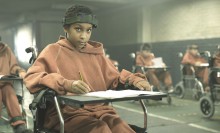George A. Romero, called the father of zombie movies, recently complained jokingly that since Brad Pitt started to play in splatter movies, it became impossible to find funding for traditional low-funding films. This is the case when a joke is actually the truth. Blockbuster World War Z (2013) is technically the first big-budget splatter film, starring Brad Pitt, who plays an efficient and smart crisis manager and secures an ultimate happy ending. At the same time, the release of this product marked the final decrease of the genre, launched by the black-and-white Night of the Living Dead by Romero (1968). With 114,000 dollars of funding, he shot an explosive mixture of horror, psychological and political drama (the cash box was 30 million). A son of Cuban and Lithuanian immigrants, the 28-year-old debutant caused a real revolution in cinema. Namely Night of the Living Dead gave rise to the genre of zombie horror movies which has won millions of admirers throughout the world.
For a long time splatter was a kind of low-budget free area in the remote corners, or even beyond Hollywood. Hundreds of directors, splashing gallons of ketchup, applying monster makeup on the crowds, piling fearsome fantasies and dark humor in their scripts, expressed themselves in all possible ways. The story, by and far, was almost the same: the streets are crowded by living dead, and we follow the adventures of several daredevils who are trying to escape. Someone gets lucky, sometimes everyone gets killed. Unfortunately, in the 2000s this bloody feast was running to an end, first and foremost because of limited means of dramaturgy.
Romero was the first one to feel the tendency and in Land of the Dead (2005) he introduces somewhat improved zombies, who now had primitive emotions and are able to interact and act together. But the real final chord was British Colin (2008), shot, as far as the legend goes, for 45 pounds. It shows the events through the eyes of a young zombie man, who calls for sympathy in the background of living people who turned into beasts. Although both films are absolutely different, they were united by showing the “walkers” not as a faceless carnivore mass, but an alternative form of human life. The directors made a statement that splatter as a democratic and non-conformist entertainment has come to an end. Now zombie film has turned into a part of Hollywood show business that enjoys great investments, has predictable plot, and stars famous actors of Brad Pitt or Mila Jovovich’s (Resident Evil) caliber.
In less ambitious projects the conflict develops between the feuding tribes, the homo sapiens species and its changed form, like, actually, in The Girl with All the Gifts, based on the eponymous novel by Mike Carey, director: Colm McCarthy.
This time a poisonous fungus turns people into devourers of living flesh. But there is an example: some kids can live with the fungus and keep clear mind at the same time. They can live also side by side with the zombie ‘hungries,’ although have the same food preferences. Actually, the main heroine is one of these miraculous children. Eight-year-old Melanie with several tens children of her age is kept in an underground facility. The researchers want to invent vaccine to fight the infection with the help of the kids. One day, because of an extraordinary situation, Melanie leaves the facility with a group of scientists and military men, becoming the last hope of humankind for survival.
The atmosphere is the strongest feature of the film. Colm McCarthy manages to turn London into menacing empty space. Ukraine helped him in doing so, because several scenes were shot in Prypiat. McCarthy noted, “I was very interested in post-apocalyptic imagery and urban exploration. We wanted to surprise people rather than have people coming in expecting a studio level film. We sent a micro drone unit to Prypiat, Chornobyl to shoot helicopter footage with Prypiat doubling for urban London.” I wonder why Kyiv with its fitting landscapes hasn’t yet become the capital of apocalyptic movies. But this is a different topic.
Actor’s performance deserves an additional mentioning. In particular, Gemma Arterton as Melanie’s mentor, Glenn Close as her antagonist, a cool-blooded explorer, and of course Sennia Nanua as Melanie. Thanks to her heroine, the last conflict goes beyond the framework of a horror movie. It’s about the fight between two tribes, with one of them having no place on the planet. In spite of the well-known components of the genre, The Girl with All the Gifts is not a splatter, but rather a convincing and extremely pessimistic anti-utopian movie. The greatest tragedy is that there are no right or guilty.
The success of the film proves again that zombie horror movies as they used to be have no future. The Girl with All the Gifts is a new stage of the cinema, where the living dead are only part of the scene, and the heroes solve the eternal question that has been troubling the humankind since the beginning of civilization: what to do with the Other.








